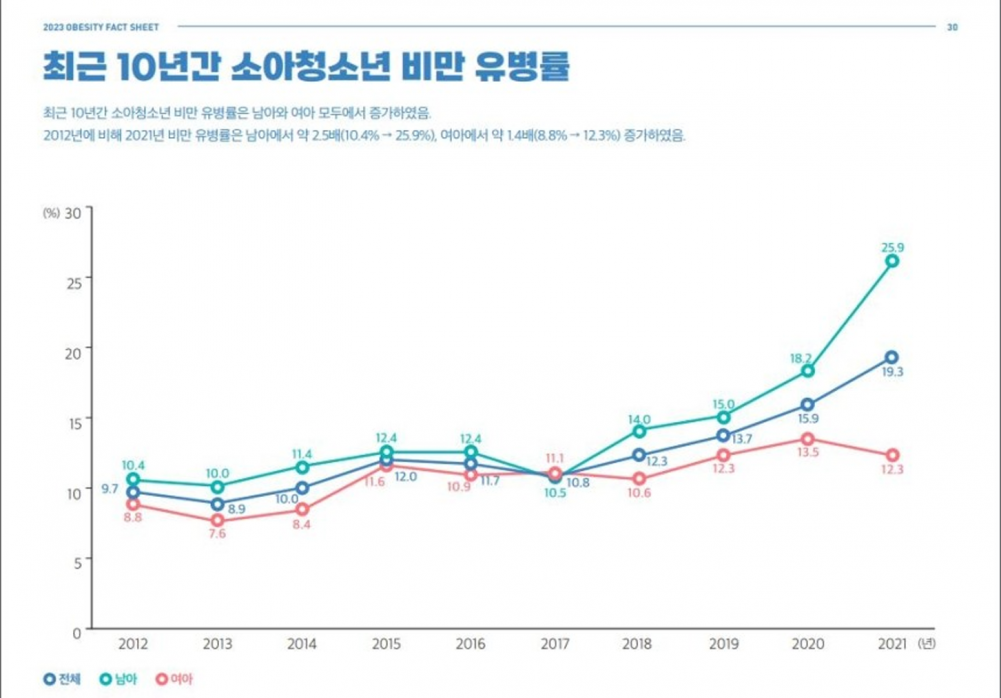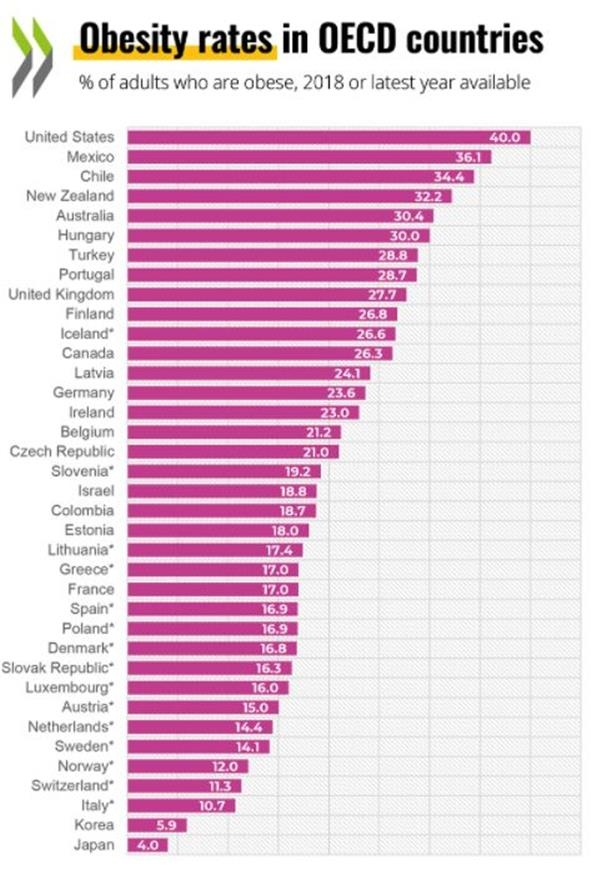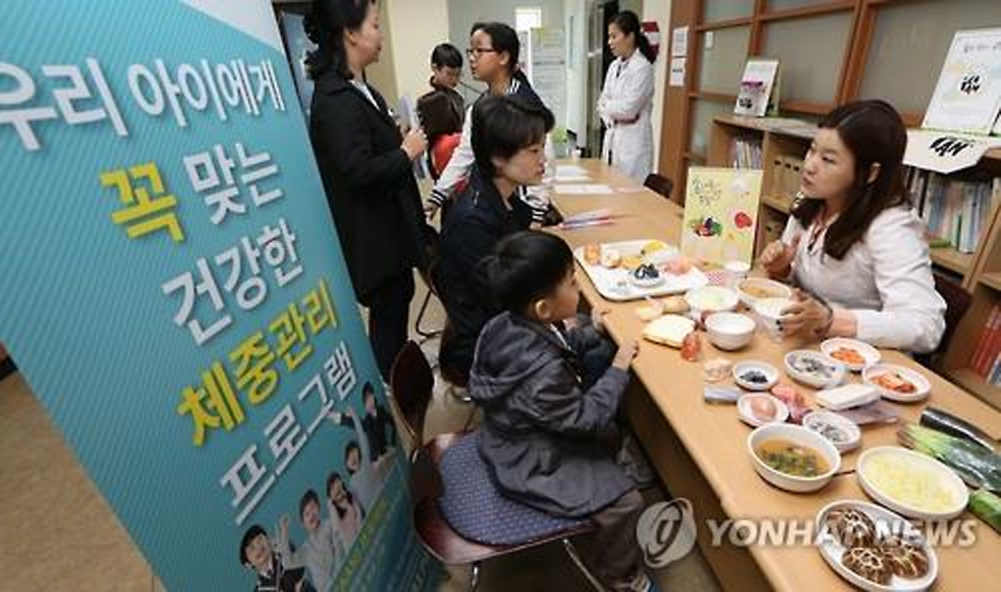
Reports highlighting concerns about childhood and adolescent obesity in South Korea due to Westernized eating habits and a chronic lack of physical activity have become increasingly common.
In recent years, high-calorie, high-sugar foods such as brown sugar drinks, Malatang (spicy hot pot), Tanghulu (sugar-coated fruits), and yogurt ice cream have gained immense popularity among younger generations. These foods have been criticized for exacerbating obesity issues.
Childhood obesity can lead to various adult diseases, place strain on bones and joints, and hinder physical development. Additionally, obese children may be teased by their peers, negatively impacting their emotional and social growth.
Statistics indicate that childhood obesity rates in South Korea have been steadily increasing.
According to the Korean Society for the Study of Obesity, the childhood obesity prevalence rate nearly doubled from 9.7% in 2012 to 19.3% in 2021. During this period, the obesity rate among boys increased from 10.4% to 25.9%, about 2.5 times higher, whereas for girls, it rose from 8.8% to 12.3%.
The Ministry of Education’s '2023 Student Health Examination Sample Statistics and Youth Health Behavior Survey' also revealed that the proportion of obese elementary, middle, and high school students grew from 23.9% in 2017 to 29.6% in 2022.
Notably, obesity rates were higher among rural students (34.4%) compared to urban students (28.7%). Among regional education offices, Jeollanam-do (37.1%), Jeju (35.4%), and Gyeongsangbuk-do (34.7%) had the highest overweight and obesity rates, while Sejong (25.6%), Gyeonggi (26.8%), and Seoul (27.3%) had the lowest.

A joint research team from the National Evidence-based Healthcare Collaborating Agency, Soonchunhyang University Bucheon Hospital, Korea University Anam Hospital, and Korea University School of Health Sciences published a study in 'PLOS ONE' in November 2023. Their study, 'Changes in Weight Distribution and Obesity Trends in East Asian Children and Adolescents,' compared obesity rates among children and adolescents aged 5-19 in South Korea, China, Japan, and Taiwan.
The results showed that South Korea had the highest obesity rates among all four countries. In 2022, obesity rates among boys and girls in South Korea were 43.0% and 24.6%, respectively, surpassing Taiwan (boys 31.0%, girls 20.5%), China (boys 24.9%, girls 19.9%), and Japan (boys 19.0%, girls 13.6%).
Between 2010 and 2022, South Korean girls saw a decrease in normal weight (-3.4 percentage points) and overweight (-0.1 percentage points) but an increase in underweight (+0.4 percentage points) and obesity (+3.1 percentage points). Among boys, normal weight saw a significant decline (-10.0 percentage points), while underweight (+0.4 percentage points), overweight (+2.8 percentage points), and obesity (+6.8 percentage points) increased.
The research team expressed concern about the significant rise in overweight and obesity rates among South Korean boys, emphasizing the need for a multifaceted approach, including promoting healthy eating habits, increasing physical activity, and implementing effective public health policies.
However, South Korea's overall obesity rate is not among the highest globally.
While there is no simple comparison of childhood and adolescent obesity across all countries, the 2022 Organization for Economic Cooperation and Development (OECD) data ranked South Korea's adult obesity rate at 5.9%, placing it 31st among 32 countries. The only country with a lower obesity rate was Japan (4.0%).
Obesity is not merely about excessive weight but also involves an increase in the number or size of fat cells, which leads to excessive fat accumulation beneath the skin and within body tissues.
The World Health Organization (WHO) classified obesity as a disease in 1997, and the American Medical Association (AMA) upgraded obesity from a "concerning health condition" to a "disease requiring treatment" in 2013.

In South Korea, the WHO’s Western Pacific Region criteria define BMI (body mass index, calculated as weight divided by the square of height) between 23.0 and 24.9 as the "pre-obese" stage (overweight), while a BMI of 25.0 or higher is classified as "obese." However, for children and adolescents, BMI percentiles are used, with the 85th-94.9th percentile categorized as overweight and the 95th percentile or higher as obese.
Childhood obesity is a major contributor to early-onset adult diseases such as hyperlipidemia, hypertension, and diabetes. More than half of severely obese children continue to be obese into adulthood, making obesity a chronic disease that is difficult to treat.
Unlike adults, where obesity is often due to the enlargement of fat cells, childhood obesity primarily involves an increase in the number of fat cells. Once these cells increase in number, even weight loss in adulthood does not reduce their quantity, increasing the risk of obesity relapse and severe obesity.
The main causes of increasing childhood obesity include a lack of physical activity among younger age groups and poor eating habits, particularly the consumption of high-calorie, high-fat, and high-sugar foods.

Only recently have "zero-calorie" and "low-sugar" food trends gained traction, raising awareness of sugar intake. However, according to a 2022 analysis by the Ministry of Food and Drug Safety, South Korean adolescents exceeded the WHO’s recommended daily sugar intake, consuming more than 10% of their total daily calories from sugar.
A study titled 'Trends in Dietary Behavior of Korean Adolescents: 2013–2022 Youth Health Behavior Survey' found that South Korean adolescents' overall eating habits have worsened. Breakfast skipping rates and energy drink consumption have steadily increased, while fruit, vegetable, and milk consumption has declined.
Interestingly, the study also noted that weakened parental supervision over children's diets contributed to poor eating habits. In 2022, about 70% of adolescents had dined out with friends or alone without their parents, and over half of them did so to eat "delicious food."
Parental mealtime involvement also decreased with age. While 66.3% of sixth graders ate meals with their parents, this figure dropped to 42.4% by ninth grade. Additionally, the percentage of adolescents watching TV or using smartphones while eating rose from 28.7% to 44.4%.
Given the significant social costs of rising childhood obesity rates, the South Korean government has implemented various preventive measures.
Under the 'Special Act on Children's Food Safety Management,' Article 8 allows the Ministry of Food and Drug Safety to restrict or prohibit the sale of high-calorie, low-nutrition foods and high-caffeine products in schools and designated child-friendly food stores.
The Ministry of Food and Drug Safety, in collaboration with the Ministry of Education, has developed guidelines to help schools reduce sugar consumption in school meals and has provided low-sugar recipes for commonly served dishes. Many regional education offices have also increased budgets to improve the quality of school meals.
Other countries' proactive measures to curb obesity, such as imposing taxes on obesity-inducing foods and beverages, could offer valuable lessons.

According to the Korea Insurance Research Institute’s 'Obesity Trends and Policy Responses in Major Countries,' France’s soda tax (levied on drinks containing sugar or artificial sweeteners) led to a 6.7% decrease in sugary drink consumption within two years. In the U.S., soda tax implementation resulted in a 21% reduction in carbonated beverage consumption.
In a policy recommendation published in the official journal of the Korea Disease Control and Prevention Agency, experts noted that while South Korea has implemented various anti-obesity measures, they remain fragmented across different government departments. They emphasized the need for a clear national obesity prevention strategy, including financial support, legal and institutional reforms, and an integrated approach across sectors.
A Ministry of Food and Drug Safety official stated, "While efforts by schools and the government are crucial, fostering healthy eating habits at home, ensuring adequate physical activity, and promoting proper sleep habits are essential in preventing obesity from persisting into adulthood."
SEE ALSO: South Korea sees largest surge in marriages and births in 18 years
 SHARE
SHARE













































